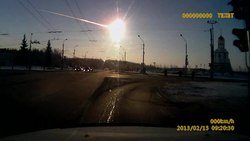From Wikipedia, the free encyclopedia
|
(image link) Meteor fireball seen from Kamensk-Uralsky where it was still dawn, in an oblast north of Chelyabinsk |
|
| Date | 15 February 2013 |
|---|---|
| Time | 09:20 YEKT (UTC+06:00) |
| Location | |
| Coordinates | 55.150°N 61.410°ECoordinates: 55.150°N 61.410°E[1] |
| Also known as | Chelyabinsk meteorite[2] |
| Cause | Meteor air burst |
| Injuries | 1,491[3] |
| Property damage | Over 7,200[4] damaged buildings, collapsed factory roof, shattered windows |
Due to its enormous velocity and shallow atmospheric entry angle, the object exploded in an air burst over Chelyabinsk Oblast, at a height of about 23.3 km (14.5 miles). The explosion generated a bright flash, producing many small fragmentary meteorites and a powerful shock wave. The atmosphere absorbed most of the object's energy, with a total kinetic energy before atmospheric impact equivalent to approximately 440 kilotons of TNT (about 1.8 PJ), 20–30 times more energy than was released from the atomic bomb detonated at Hiroshima.
The object was undetected before its atmospheric entry and its explosion created considerable confusion among local residents. About 1,500 people were injured seriously enough to seek medical treatment. All of the injuries were due to indirect effects rather than the meteor itself, mainly from broken glass from windows that were blown in when the shock wave arrived, minutes after the superbolide's flash. Some 7,200 buildings in six cities across the region were damaged by the explosion's shock wave, and authorities scrambled to help repair the structures in sub-zero temperatures.
With an estimated initial mass of about 10,000 tonnes (11,000 short tons, heavier than the Eiffel Tower), and measuring between 17 to 20 metres in size, it is the largest known natural object to have entered Earth's atmosphere since the 1908 Tunguska event that destroyed a wide, remote forest area of Siberia. The Chelyabinsk meteor is also the only meteor confirmed to have resulted in a large number of injuries. The predicted close approach of a second asteroid, the roughly 30-metre 2012 DA14 occurred about 16 hours later; detailed analysis of the two objects later determined that they were unrelated to each other.



No comments:
Post a Comment